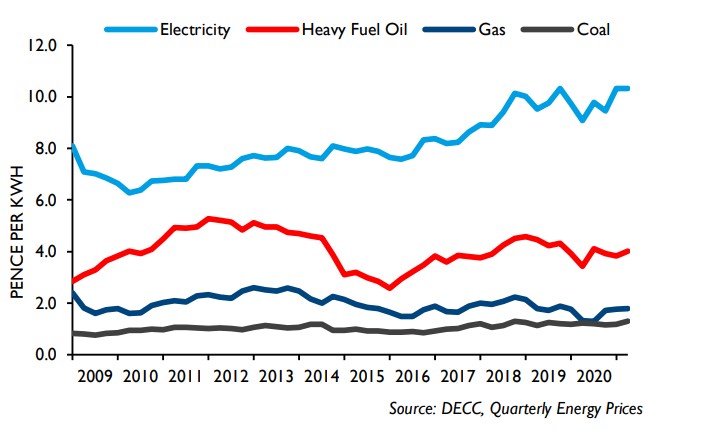14 October 2021

Energy sector commentary - special update ahead of the next Printing Outlook
In the last three months global gas wholesale prices have skyrocketed to record levels, dragging electricity prices with them - it is fair to call this an energy crisis. The themes touched on in the last Printing Outlook report remain the key drivers behind the huge market volatility we have seen recently - rebounding global economic demand and tight commodity supply. The gas and power markets are following a classic over-correction cycle that we normally see in crude markets. A downward demand 'shock' (Covid lockdown) causes a collapse in the price, then the robust recovery from that downturn leads to supply-side constraints, and the price leaps. In the period since the last Outlook's analysis, Brent crude has risen $10, or around 12%, to $83/barrel. Meanwhile, sterling has fallen around 1% against the dollar to $1.36/£, meaning that the rise in oil prices has been slightly higher for UK customers - 12.9%. Compared with a year ago, Brent crude has now more than doubled in both dollar (+125%) and Sterling (+113%) terms.
Gas markets have fallen back from record levels in the last couple of weeks but are still extremely elevated and volatile as we head into winter. Year-ahead natural gas wholesale quotations (out of April 22) are 26% higher than in July, however the greatest panic is reserved for the 'front months' for the coming winter, where the market is operating at a pricing level 4 or 5 times the equivalent levels of a year ago. Looking beyond the current winter, that year-ahead price is basically 2.5 times the price as at a year ago. Electricity prices are heavily influenced by the prevailing gas and coal markets, as those fuels used for power generation still tend to set or influence the marginal cost. Coal has been trading at record levels too, as markets look for an alternative to gas for power generation, and due to its dirtier nature in terms of emissions, this has also boosted the carbon price - which again feeds through to electricity wholesale prices. Like gas, electricity year-ahead markets (out of April 2022) are more than a quarter higher since the last update and are 2.3 times the level seen a year ago. The prices for this winter are even higher.
Buyers who took the opportunity in 2020 to contract long-term forward for business electricity and gas supply contracts will have been insulated from these impacts, whereas those still with exposure to unfixed contract renewals will be braced for very significant price increases, depending of course on when they placed their last contract. The 'traditional' business energy supply renewal season is for 1st October starts, with prices tending to be negotiated in advance, so if fixed price deals were struck earlier in the summer, then recent price spikes would have limited short term impact.
Oil markets have continued to increase in the last quarter on rebounding global demand for the fuel, and supply-side constraints. The resurgence in coal and gas prices worldwide also increases potential demand for oil products as heating fuel over the northern hemisphere winter. Global gas prices have hit record levels in multiple regions. Robust Asian demand has increased competition for global liquefied natural gas (LNG) tanker deliveries, with European markets having to 'bid up' to close the value gap. In Europe, the decline of the UK and Netherlands indigenous production has underlined reliance on Russian (and Norwegian) supplies. Both countries have faced physical supply difficulties, and Russia is prioritising filling its domestic storage facilities before the end of October. European storage levels have been significantly lower than the 5-year average, lending further volatility to the market ahead of withdrawal season. Finally, Russia is pushing for the EU to approve its NordStream 2 pipeline across the Baltic Sea to Germany. The US and some European countries are against the pipeline for strategic reasons, and there is concern that Russia may be holding back on supplies transiting through Ukraine to underline its preference to prioritise NordStream. The path of the markets from here will be driven by the weather as we move into winter, and both Russian and LNG physical deliveries. Volatility is almost certain.
MANUFACTURING INDUSTRY FUEL PRICES – IN CASH TERMS

NOTE: The Q3 price data has not yet been published but will be available in the next BPIF Printing Outlook report.
Source: David Hunter, Director of Market Studies at Schneider Electric
Downloads Sexual Harassment – 'Preventative Duty’
Sexual Harassment – 'Preventative Duty’
25 November 2024
The Worker Protection Act 2023 (Amendment of the Equality Act 2010), is UK legislation designed to enhance protections against workplace sexual harassment.
 INTERGRAF OPENS APPLICATIONS FOR THE 2025 YOUNG TALENT AWARD
INTERGRAF OPENS APPLICATIONS FOR THE 2025 YOUNG TALENT AWARD
4 December 2024
Intergraf is pleased to announce that applications are now open for the 2025 Young Talent Award, an initiative designed to inspire and shape the future of the print industry. This year, the Award invites young talent to explore how print companies can effectively attract and engage younger generations to pursue careers in the print industry.











